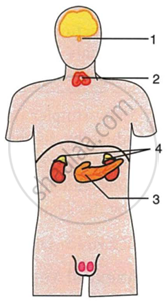Advertisements
Advertisements
प्रश्न
Given alongside is an outline diagram of human body showing position of certain organs.
 |
- Name the parts numbered 1 to 4.
- What is common to all these parts in regard to the nature of their functions?
- Name the nutrient element which is essential for the normal working of part 2.
उत्तर
-
- Pituitary gland
- Pituitary gland
- Pancreas
- Adrenal glands.
- They regulate chemical production to maintain homeostasis and impact various bodily activities. They play a crucial role in regulating growth and development.
- Iodine is a vital vitamin for the thyroid gland to function properly.
APPEARS IN
संबंधित प्रश्न
Diagrammatically indicate the location of the various endocrine glands in our body.
In the table given below, fill in the blanks by naming endocrine glands, the hormones they secrete, and the function they perform, in a normal person.
| S.No. | Name of the gland | produced | Function |
| 1. | Thyroid | ||
| 2. | Insulin | ||
| 3. | Preparing the body for action | ||
| 4. | (i) Growth hormone (ii) Thyroid-stimulating hormone |
What is a hormone?
Is the following gland an exocrine or an endocrine gland?
Liver
Give the Technical Term: Name a hormone which controls developments of male secondary sexual characters.
Column ‘II’ is a list of items related to ideas in Column ‘I’. Match the term in Column ‘II’ with a suitable idea given in Column ‘I’.
| Column A | Column B |
| (i) Pituitary | (a) produces male sex characteristics |
| (ii) Ovaries | (b) decreases blood sugar level |
| (iii) Thyroid | (c) increases heart and breathing rate raises blood pressure |
| (iv) Thymus | (d) produces female sex characteristics |
| (v) Adrenals | (e) is known as emergency hormone |
| (vi) Hypothalamus | (f) regulates the level of calcium and phosphorus |
| (vii) Pancreas | (g) increases the rate of metabolism |
| (viii) Testes | (h) maintains the level of calcium |
| (ix) Parathyroid | regulates the amount of water excreted in the urine. |
| (x) Cretinism | (j) simulates skeletal growth |
| (xi) Diabetes mellitus | (k) regulates the activities of other glands |
| (xii) Insulin shock | (l) stimulates the development of male and female sex organs |
| (xiii) Gigantism | (m) Shortage of glucose in the blood. |
| (xiv) Enlargement of breasts in adult males | (n) Over-secretion of growth hormone |
| (xv) Exophthalmic goiter | (o) Excess of glucose in the blood |
| (xvi) Acromegaly | (p) Over-secretion of thyroxin |
| (xvii) Addison’s disease | (q) Dwarfism and mental retardation |
| (xviii)Cretinism | (r) Over-secretion of cortical hormones |
| (xix) Dwarfism | (s) Under-secretion of the adrenal cortex |
| (xx) Adrenalin | (t) Under-secretion of thyroxin in children |
| (xxi) Vasopressin | (u) Over-secretion of growth hormones in adults |
Comment on homeostasis.
Briefly explain the structure of thyroid gland.
______ gland is located in the neck region.
Distinguish between Diabetes mellitus and Diabetes insipidus (endocrine gland concerned).
